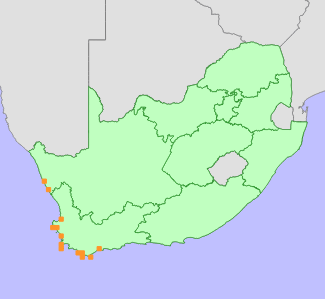|
Scientific Name | Oncosiphon sabulosum (Wolley-Dod) Källersjö |
Higher Classification | Dicotyledons |
Family | ASTERACEAE |
Synonyms | Matricaria sabulosa Wolley-Dod, Pentzia sabulosa (Wolley-Dod) Hutch. |
National Status |
Status and Criteria | Least Concern |
Assessment Date | 2018/05/30 |
Assessor(s) | L. von Staden |
Justification | Oncosiphon sabulosum is a widespread and still common species in spite of extensive habitat loss and degradation across its range. It has an extent of occurrence (EOO) of 50 141 km², and is not yet in danger of extinction, but the population needs to be monitored. It is therefore listed as Least Concern. |
Distribution |
Endemism | South African endemic |
Provincial distribution | Northern Cape, Western Cape |
Range | This species is endemic to South Africa, and is found from the Namaqualand coast to the Agulhas Plain. |
Habitat and Ecology |
Major system | Terrestrial |
Major habitats | Namaqualand Coastal Duneveld, Overberg Dune Strandveld, Cape Flats Dune Strandveld, Cape Seashore Vegetation, Namaqualand Seashore Vegetation, Namaqualand Inland Duneveld, Langebaan Dune Strandveld, Saldanha Flats Strandveld, Hangklip Sand Fynbos, Namaqualand Strandveld, Namaqualand Heuweltjie Strandveld, Saldanha Limestone Strandveld, Saldanha Granite Strandveld |
Description | It occurs in coastal dunes. |
Threats |
| Oncosiphon sabulosum has lost habitat to tourism-related coastal infrastructure development, as well as coastal housing developments in places. On the Agulhas Plain and parts of the Cape Peninsula it is also threatened by dense infestations of alien invasive wattles. On the Namaqualand coast it is threatened by ongoing habitat loss and degradation due to open-cast sand mining. |
Population |
This widespread and relatively common species is known from many recent observations indicating that it occurs in at least 20 locations. The population however continues to decline, and it is likely to become in danger of extinction within the near future.
|
Population trend | Decreasing |
Assessment History |
Taxon assessed |
Status and Criteria |
Citation/Red List version | | Oncosiphon sabulosum (Wolley-Dod) Källersjö | Least Concern | Raimondo et al. (2009) | |
Bibliography |
Goldblatt, P. and Manning, J.C. 2000. Cape Plants: A conspectus of the Cape Flora of South Africa. Strelitzia 9. National Botanical Institute, Cape Town.
Harvey, W.H. 1894. Compositae. In: W.H. Harvey and O.W. Sonder (eds). Flora Capensis III (Rubiaceae to Campanulaceae):44-530. L. Reeve & Co., Ltd., Ashford.
Hutchinson, J. 1916. Notes on African Compositae: III. Pentzia, Thunb. Bulletin of Miscellaneous Information (Royal Botanic Gardens, Kew) 1916(10):241-254.
Källersjö, M. 1988. A generic re-classification of Pentzia Thunb. (Gompositae-Anthemideae) from southern Africa. Botanical Journal of the Linnean Society 96(4):299-322.
Manning, J.C. and Goldblatt, P. 2012. Plants of the Greater Cape Floristic Region 1: The Core Cape Flora. Strelitzia 29. South African National Biodiversity Institute, Pretoria.
Raimondo, D., von Staden, L., Foden, W., Victor, J.E., Helme, N.A., Turner, R.C., Kamundi, D.A. and Manyama, P.A. 2009. Red List of South African Plants. Strelitzia 25. South African National Biodiversity Institute, Pretoria.
|
Citation |
| von Staden, L. 2018. Oncosiphon sabulosum (Wolley-Dod) Källersjö. National Assessment: Red List of South African Plants version 2024.1. Accessed on 2025/11/17 |
 Comment on this assessment
Comment on this assessment


